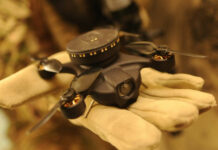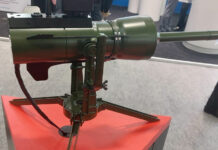Infantry weapons firepower enhancement is provided by more accurate improved performance of kinetic ammunition, including lethal and less-than-lethal small arms and advanced multi-purpose munitions, such as 40mm grenades. The use of optical sights, including red-tot reflection and magnifying optics (x1.5 – x3) improve target discrimination in daylight and nighttime use. Night combat gear is also provided in growing numbers, as this capability is still considered advantageous for the superior equipped regular forces.
Lightweight night sights include daylight reflection sights used in tandem with night vision devices, or dedicated night sights, integrated with image intensifiers (I2) or thermal sensors. Laser aiming lights complement night vision devices offering accurate coordination of fire, at close ranges. Thermal sights although heavier and bulkier, provide significant advantages for operations in total darkness such as in underground facilities or caves; they also contribute significantly for the ability to acquire and discriminate between false and valid targets through clutter, dust, smoke or camouflage. Weapon mounted electro-optical sights also support intelligence collection and dissemination via video communications, improving control and coordination of forces. A byproduct is also the ability to aim and fire weapons behind corners or obstacles. Systems are offered as complete solutions such as CornerShot, while others are available as add-on kits for existing weapons. Optical sights, and Sight/Camera combinations are becoming a standard issue for all future infantry combat suits.
Further improvement in firepower is provided by fire control systems (FCS) for assault rifles and support weapons, including long-range sharpshooting weapons, and support weapons such as 40mm grenades. For small arms, FCS are provided by miniature embedded computers and displays integrating compact laser ranging systems. Systems include electro-optics for target acquisition and marking, range measurement equipment coupled with the optical sight, to project a ballistic corrected aim-points for accurate long range engagements. The use of such integrated FCS enables firing of pre-programmable time-activated air-burst munitions, for enhanced effect against soft, or protected targets.
By improving the capabilities of dismounted infantry and expanding the use of precision weaponry, modern armies are maintaining their technological superiority and are able to fight and win without risking too many casualties among their own troops and non combatants. To maintain this capability armies are beginning to operate “human-centric” weapon systems, balancing soldier’s performance and capabilities in firepower, survivability, mobility, command and control addressing them as a complete and integrated ensemble. Some of these capabilities are available today and used worldwide in combat operations worldwide. Particularly advanced infantry combat suits, are currently under development and should be fielded within the next five years.
Additional parts of this article:
- Infantry Combat Suits
- Infantry Combat Suits – Firepower
- Infantry Combat Suits – Survivability & Protection
- Infantry Combat Suits – Mobility & Ergonomics
- Infantry Combat Suits – Computers & Communications
- Future Force Warrior Uniform, Protection and Combat Gear
- Future Force Warrior Communication and Computation
- Future Force Warrior Infantry System of Systems (SOS)
- Felin Infantry Combat Suite



















